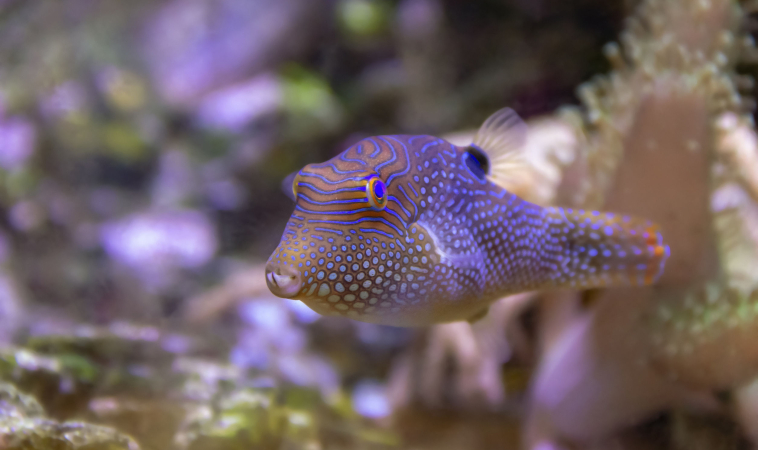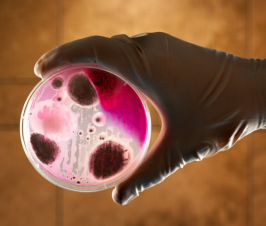In Japan, pufferfish is considered a delicacy, but the tickle to the taste buds comes with a tickle to the nerves. Fugu contains tetrodotoxin, a strong nerve toxin. In low doses, tetrodotoxin is shown in clinical trials to be a replacement for opioids in relieving cancer related pain. In the journal Angewandte Chemie, scientists have introduced a new route for the total synthesis (complete production of a natural product from current materials) of tetrodotoxin.
Tetrodotoxin, a strong nerve toxin, is found in Fugu
Eating fugu initially elicits a light prickling in the mouth, which can have a relaxing or euphoric effect — assuming the cook knows what he or she is doing. If the fish is incorrectly prepared, things can end badly: Tetrodotoxin blocks the voltage-gated sodium channels, and thus nerve impulses. This may result in paralysis and even difficulty breathing. In the EU, the importation and preparation of fugu as food is forbidden. In Japan and other countries, a number of strict laws regulate the preparation and consumption of pufferfish products. However, there are occasional deaths.
In very low doses, tetrodotoxin is a pain-reliever
In very low doses, tetrodotoxin is a pain-reliever and could be used to treat severe pain, such as in the treatment of cancer. Early clinical studies are underway. It is thus important to develop a simple, reliable synthetic method to provide access to tetrodotoxin and structurally related compounds — for research and eventually robust and inexpensive production.
Tetrodotoxin has a unique, highly complex, cage-like structure
Tetrodotoxin has a unique, highly complex, cage-like structure (a tricyclic orthoester) as well as a cyclic guanidine component. Guanidine is an important component of many biological molecules, including arginine. The tetrodotoxin framework is highly oxidized and has five hydroxy groups (-OH) as substituents. A number of different total syntheses of tetrodotoxin have previously been published, including one from researchers led by Satoshi Yokoshima at the Nagoya University (Japan) in 2017. Now Yokoshima and his team have introduced another, novel total synthesis.
The key step
The key step is a Diels-Alder reaction between a known starting compound (an enone) and a silicon-containing component (a siloxyldiene) to make a tricyclic intermediate with the right spatial (steric) arrangement to allow for proper attachment of the hydroxy groups and later, construction of the “cage.” Formation of the guanidine component begins with introduction of an amino group — either by a conventional four-step method or a three-step reaction sequence based on a newly developed conversion of a terminal alkyne to a nitrile. Finally, the “bridges” needed for formation of the cage are built up over several steps. A cross-coupling reaction was used for introducing a carbon substituent (hydroxymethyl group) on the cage. Employing other components for the cross coupling reaction might lead to producing structurally related molecules.
Source:
- Keigo Murakami, Tatsuya Toma, Tohru Fukuyama, Satoshi Yokoshima. Total Synthesis of Tetrodotoxin. Angewandte Chemie International Edition, 2020; DOI:10.1002/anie.201916611
 Razi Berry is the founder and publisher of the journal Naturopathic Doctor News & Review, which has been in print since 2005, and the premier consumer-faced website of naturopathic medicine, NaturalPath. She is the host of The Love is Medicine Project docuseries, The Natural Cancer Prevention Summit, The Heart Revolution-Heal, Empower and Follow Your Heart, and the popular 10-week Sugar Free Summer program. From a near death experience as a young girl that healed her failing heart, to later overcoming infertility and chronic fatigue syndrome and fibromyalgia through naturopathic medicine, Razi has lived the mind/body healing paradigm. Her projects uniquely capture the tradition and philosophy of naturopathy: The healing power of nature, the vital life force in every living thing and the undeniable role that science and mind/body medicine have in creating health and overcoming dis-ease. You can follow Razi on social media: Facebook at Razi Berry, Instagram at Razi.Berry and join the Love is Medicine group to explore the convergence of love and health. Look for more, and listen to more Love is Medicine podcast episodes here.
Razi Berry is the founder and publisher of the journal Naturopathic Doctor News & Review, which has been in print since 2005, and the premier consumer-faced website of naturopathic medicine, NaturalPath. She is the host of The Love is Medicine Project docuseries, The Natural Cancer Prevention Summit, The Heart Revolution-Heal, Empower and Follow Your Heart, and the popular 10-week Sugar Free Summer program. From a near death experience as a young girl that healed her failing heart, to later overcoming infertility and chronic fatigue syndrome and fibromyalgia through naturopathic medicine, Razi has lived the mind/body healing paradigm. Her projects uniquely capture the tradition and philosophy of naturopathy: The healing power of nature, the vital life force in every living thing and the undeniable role that science and mind/body medicine have in creating health and overcoming dis-ease. You can follow Razi on social media: Facebook at Razi Berry, Instagram at Razi.Berry and join the Love is Medicine group to explore the convergence of love and health. Look for more, and listen to more Love is Medicine podcast episodes here.

















